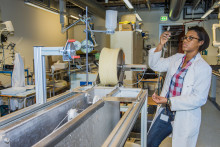‘This is our newly developed membrane,’ says PhD scientist Terica Sinclair of UT’s Membrane Science and Technology cluster. ‘With a little more development, this could change the lives of many people in developing countries in the future.’ She holds a bundle of white, hollow fibers in her hands. Each fiber roughly measures half a millimeter in diameter.
For several years, chemical engineer Sinclair has been working at Wetsus, European centre of excellence for sustainable water technology in Leeuwarden, to develop a simple and effective way to purify contaminated drinking water from water-borne pathogens. And with good reason. At the moment, one in ten people doesn’t have access to clean drinking water, a staggering 780 million people worldwide. Contaminated water is responsible for the death of over 5000 children every day because of water-borne bacterial or viral infections. Without any action, this problem will dramatically increase over time due to climate change and a growing world population. Sinclair is highly motivated to help solve this problem: ‘After the earthquakes in Haiti, I worked there as a volunteer and I saw the huge need for uncontaminated water with my own eyes,’ she says. ‘I decided to dedicate my career to contribute to a solution of the problem.’
Simple technology
Purifying drinking water using membranes is a recognized method. Bacteria can easily be removed by the principle of microfiltration, a simple technology where water is forced through a porous membrane containing tiny holes of about 1 µm, smaller than most microorganisms.
Usually, gravity delivers enough pressure to pass the water through the membrane. Bacteria are too large to pass through the membrane holes and are contained. However, most viruses are not. To remove viruses, more sophisticated so called ultra-filtration membranes are needed. Pore sizes are as small as 10-20 nm. But to pass water through the tiny holes of such a membrane, a high pressure is needed. This can be delivered by, for example, powerful pumps. For many developing countries, however, this is too complicated and too costly. Flawless operation requires specialized technical knowledge and pump maintenance. Therefore, a different membrane design was required: low cost and simple technology to guarantee effective operation.

Anti-viral coating
To develop a simple, but effective membrane capable of removing viruses, the membrane scientists dug into piles of literature. They discovered that walls of surgery rooms were painted with anti-viral polymer coatings. They wondered if similar coatings could be used to cover their membranes to make it an effective anti-viral barrier.
The first challenge was to attach the polymer coating to the membrane surface. Because the membrane and the coating have opposite electrical charges, attaching the coating to the membrane was relatively easy: simply dipping a flat sheet membrane into the positively charged polymer solution was enough. For tube-shaped membranes, the polymer solution was flushed through the hollow membrane fibers or blended in the polymer solution that is used to make these hollow fiber membranes.
By adding copper and silver-based nanoparticles to the coating, the membrane became even more deadly for viruses and bacteria. At the same time, these nanoparticles worked as anti-fouling, thereby preventing growth and obstruction of the membrane filter by other microorganisms.

Proof of principle
With the prototype complete, the team was ready to start testing the first membranes for the ability to inactivate viruses. ‘I’m a chemical engineer, not a virologist,’ says Sinclair. ‘Therefore, this was a tough part, but eventually we managed to get consistent results and showed the proof of principle: our idea worked!’ Sinclair used bacterial viruses to test her coated membrane for virus inactivation. She passed water containing these ‘surrogate’ viruses through her membrane and tested the water before and after filtration for the presence of these viruses. Her experiments proved that the membrane removed 99.9% of the viruses.
Sinclair puts her findings into perspective: ‘Our results are of course limited by the tools and methods we used. But still this was a great moment!’ Now the team could move to the real stuff: together with the Department of Virology of RIVM the membrane will be tested with actual pathogenic viruses like the rota- and adenoviruses as well as hepatitis A. These tests are necessary because the proof of principle was demonstrated for one ‘surrogate’ virus only. These bacterial viruses might be easier to remove than ‘real’ pathogenic viruses. ‘Only such tests mimicking the real-life situation can give conclusive evidence that the method will also work in the field,’ states Sinclair.

Low cost
Within months all tests will be completed, Sinclair expects. Then the membrane has to be fitted into a module, containing a bundle of membrane fibres, that is easy to operate and above all: of low cost. ‘The manufacturer will simply glue a bundle of fibres into a plastic holder and assemble it,’ Sinclair explains. ‘When this model survives the field tests and operates in a good way, mass production will be started.’
The main challenge will not be the efficiency of the membrane unit, but keeping it affordable. The engineer expects that within months there will be working units in the field. Despite the great success of the team’s efforts, Sinclair sees the development of the virus-inactivating membrane as just a temporary answer to the need of clean water in many developing countries: ‘The ultimate solution is a good working water and sanitation system,’ she says. ‘If we manage to eventually develop a successful membrane, it will hopefully cover the needs of many people and supply them with safe drinking water until such a sanitation structure is established.’
Financially the project was made possible by Waterinstitute Wetsus and the companies NX Filtration, WLN, AquaNirvana and Berson.










